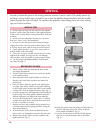
9
STITCH SELECTOR DIAL [Fig. 1]
To select a stitch, turn the stitch selector dial until the
letter that corresponds with the desired stitch shows in
the window.
STITCH WIDTH DIAL [Fig. 2]
The stitch width dial is numbered 0 - 5, representing
the various stitch widths in millimeters. The higher the
number, the wider the stitch. The yellow color-coding
between 3 and 5 represent the width range for making
buttonholes.
To select a stitch width, turn the dial until the desired
width setting is aligned with the indicator dot.
STITCH LENGTH DIAL [Fig. 3]
The stitch length dial is numbered 0 - 4 representing the
various stitch lengths in millimeters. The higher the
number, the longer the stitch.
To select a stitc
h length turn the dial until the desired
length setting is aligned with the indicator dot.
When set at 0 the fabric will not feed under the presser foot.
NEEDLE PLATE SEAM GUIDES [Fig. 4]
The five seam guide markings on the right side of the
needle plate are set at 1/8” intervals. The first mark is
1/2" from the needle; the second, 5/8” and so on. Align
the fabric edge at a seam guide marking for a consistent
seam width. The standard seam allowance width is 5/8”.
REVERSE SEWING LEVER [Fig. 5]
Use the reverse sewing lever to secure the beginning
and ends of seams.
With the foot control depressed, push and hold the
reverse lever down to sew in reverse. Release the lever
to return to forward sewing.
STITCH SELECTION
Each built-in stitch can be customized by making stitch length and stitch width adjustments.
T
he stitches are color-coded to correspond with the stitch length and width settings. Select a
stitch, then set the stitch length and width dials within the color range. These color ranges are
guidelines and may vary for some sewing techniques.
SIMPLICITY CUSTOM STITCH SELECTION
Fig. 1
Fig. 2
Fig. 3
Fig. 4
Fi
g. 5
1
⁄
2
”
5
⁄
8
”
3
⁄
4
”
7
⁄
8
”
1
”


















